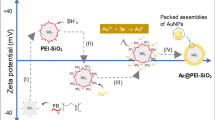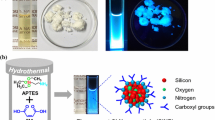Abstract
Photoluminescent silicon nanoparticles 1–2 nm in size were synthesized by a wet chemical procedure and derivatized with propylamine (NH2SiNP). Surface NH2 groups were used as linkers for additional poly(ethylene glycol) (PEG) and folic acid (Fo) attachment (PEG-NHSiNP and Fo-NHSiNP, respectively) to enable efficient targeting of the particles to tumors and inflammatory sites. The particles were characterized by transmission electron microscopy, Fourier transform infrared spectroscopy, X-ray photoelectron spectroscopy, ζ potential, dynamic light scattering, and time-resolved anisotropy.
The photophysical properties and photosensitizing capacity of the particles and their interaction with proteins was dependent on the nature of the attached molecules. While PEG attachment did not alter the photophysical behavior of NH2SiNP, the attachment of Fo diminished particle photoluminescence. Particles retained the capacity for 1O2 generation; however, efficient 1O2 quenching by the attached surface groups may be a drawback when using these particles as 1O2 photosensitizers. In addition, Fo attachment provided particles with the capacity to generate the superoxide anion radical (O −2 ).
The particles were able to bind tryptophan residues of bovine serum albumin (BSA) within quenching distances. NH2SiNP and PEG–NHSiNP ground state complexes with BSA showed binding constants of (3.1 ± 0.3) × 104 and (1.3 ± 0.4) × 103 M−1, respectively. The lower value observed for PEG-NHSiNP complexes indicates that surface PEGylation leads to a reduction in protein adsorption, which is required to prevent opsonization. An increase in particle luminescence upon BSA binding was attributed to the hydrophobic environment generated by the protein. NH2SiNP-BSA complexes were also capable of resonance energy transfer.

Similar content being viewed by others
References
Llansola Portolés, M. J.; David Gara, P. M.; Kotler, M. L.; Bertolotti, S.; San Román, E.; Rodríguez, H. B.; Gonzalez, M. C. Silicon nanoparticle photophysics and singlet oxygen generation. Langmuir 2010, 26, 10953–10960.
Burda, C.; Chen, X. B.; Narayanan, R.; El-Sayed, M. A. Chemistry and properties of nanocrystals of different shapes. Chem. Rev. 2005, 105, 1025–1102.
Llansola Portolés, M. J.; Rodriguez Nieto, F.; Soria, D. B.; Amalvy, J. I.; Peruzzo, P. J.; Mártire, D. O.; Kotler, M.; Holub, O.; Gonzalez, M. C. Photophysical properties of blueemitting silicon nanoparticles. J. Phys. Chem. C 2009, 113, 13694–13702.
Sperling, R. A.; Parak, W. J. Surface modification, functionalization and bioconjugation of colloidal inorganic nanoparticles. Phil. Trans. R. Soc. A 2010, 368, 1333–1383.
Wang, C. H.; Liu, C. J.; Wang, C. L.; Huang, T. E.; Obliosca, J. M.; Lee, K. H.; Hwu, Y.; Yang, C. S.; Liu, R. S.; Lin, H. M. et al. Optimizing the size and surface properties of polyethylene glycol (PEG)–gold nanoparticles by intese X-ray irradiation. J. Phys. D: Appl. Phys. 2008, 41,195301.
Matsumura, Y.; Maeda, H. A new concept for macromolecular therapeutics in cancer chemotherapy: Mechanism of tumoritropic accumulation of proteins and the antitumor agent smancs. Cancer Res. 1986, 46, 6387–6392.
Paciotti, G. F.; Kingston, D. G. I.; Tamarkin, L. Colloidal gold nanoparticles: A novel nanoparticle platform for developing multifunctional tumor-targeted drug delivery vectors. Drug. Develop. Res. 2006, 67, 47–54.
David Gara, P.; Garabano, N.; Llansola Portoles, M.; Moreno, M. S.; Dodat, D.; Casas, O.; Gonzalez, M.; Kotler, M. ROS enhancement by silicon nanoparticles in X-ray irradiated aqueous suspensions and in glioma C6 cells. J. Nanopart. Res. 2012, 14,741.
Klein, S.; Dell’Arciprete, M. L.; Wegmann, M.; Distel, L. V. R.; Neuhuber, W.; Gonzalez, M. C.; Kryschi, C. Oxidized silicon nanoparticles for radiosensitization of cancer and tissue cells. Biochem. Bioph. Res. Commun. 2013, 434, 217–222.
Huang, P.; Xu, C.; Lin, J.; Wang, C.; Wang, X. S.; Zhang, C. L.; Zhou, X. J.; Guo, S. W.; Cui, D. X. Folic acidconjugated graphene oxide loaded with photosensitizers for targeting photodynamic therapy. Theranostics 2011, 1, 240–250.
Lu, Y. J.; Low, P. S. Folate-mediated delivery of macromolecular anticancer therapeutic agents. Adv. Drug Deliver. Rev. 2002, 54, 675–693.
Romero, J. J.; Llansola Portolés, M. J.; Dell’Arciprete, M. L.; Rodríguez, H. B.; Moore, A. L.; Gonzalez, M. C. Photoluminescent 1–2 nm sized silicon nanoparticles: A surface-dependent system. Chem. Mater. 2013, 25, 3488–3498.
Bhattacharjee, S.; Rietjens, I. M. C. M.; Singh, M. P.; Atkins, T. M.; Purkait, T. K.; Xu, Z. J.; Regli, S.; Shukaliak, A.; Clark, R. J.; Mitchell, B. S. et al. Cytotoxicity of surface-functionalized silicon and germanium nanoparticles: The dominant role of surface charges. Nanoscale 2013, 5, 4870–4883.
Nel, A. E.; Mädler, L.; Velegol, D.; Xia, T.; Hoek, E. M. V.; Somasundaran, P.; Klaessig, F.; Castranova, V.; Thompson, M. Understanding biophysicochemical interactions at the nano-bio interface. Nat. Mater. 2009, 8, 543–557.
Erogbogbo, F.; Tien, C. A.; Chang, C. W.; Yong, K. T.; Law, W. C.; Ding, H.; Roy, I.; Swihart, M. T.; Prasad, P. N. Bioconjugation of luminescent silicon quantum dots for selective uptake by cancer cells. Bioconjugate Chem. 2011, 22, 1081–1088.
Doshi, N.; Mitragotri, S. Designer biomaterials for nanomedicine. Adv. Funct. Mater. 2009, 19, 3843–3854.
Ausubel, F. M.; Brent, R.; Kingston, R. E.; Seidman, J. G.; Smith, J. A.; Struhl, K. Current Protocols in Molecular Biology. John Wiley & Sons: New York, 2003.
Lakowicz, J. R. Principles of Fluorescence Spectroscopy, 3rd ed.; Springer Science+Business Media: New York, 2006.
Frauenheim, T.; Seifert, G.; Elstner, M.; Niehaus, T.; Köhler, C.; Amkreutz, M.; Sternberg, M.; Hajnal, Z.; Di Carlo, A.; Suhai, S. Atomistic simulations of complex materials: Groundstate and excited-state properties. J. Phys.: Condens. Matter 2002, 14, 3015–3047.
Steinbeck, M. J.; Khan, A. U.; Karnovsky, M. J. Extracellular production of singlet oxygen by stimulated macrophages quantified using 9,10-diphenylanthracene and perylene in a polystyrene film. J. Biol. Chem. 1993, 268, 15649–15654.
Llansola Portolés, M. J.; Pis Diez, R.; Dell’Arciprete, M. L.; Caregnato, P.; Romero, J. J.; Mártire, D. O.; Azzaroni, O.; Ceolín, M.; Gonzalez, M. C. Understanding the parameters affecting the photoluminescence of silicon nanoparticles. J. Phys. Chem. C 2012, 116, 11315–11325.
Warner, J. H.; Hoshino, A.; Yamamoto, K.; Tilley, R. D. Water-soluble photoluminescent silicon quantum dots. Angew. Chem. 2005, 117, 4626–4630.
Atkins, T. M.; Louie, A. Y.; Kauzlarich, S. M. An efficient microwave-assisted synthesis method for the production of water soluble amine-terminated Si nanoparticles. Nanotechnology 2012, 23, 294006.
Hua, F. J.; Swihart, M. T.; Ruckenstein, E. Efficient surface grafting of luminescent silicon quantum dots by photoinitiated hydrosilylation. Langmuir 2005, 21, 6054–6062.
Elstner, M.; Porezag, D.; Jungnickel, G.; Elsner, J.; Haugk, M.; Frauenheim, T.; Suhai, S.; Seifert, G. Self-consistentcharge density-functional tight-binding method for simulations of complex materials properties. Phys. Rev. B 1998, 58, 7260–7268.
Aradi, B.; Hourahine, B.; Frauenheim, T. DFTB+, a sparse matrix-based implementation of the DFTB method. J. Phys. Chem. A 2007, 111, 5678–5684.
Rosso-Vasic, M.; Spruijt, E.; van Lagen, B.; De Cola, L.; Zuilhof, H. Alkyl-functionalized oxide-free silicon nanoparticles: Synthesis and optical properties. Small 2008, 4, 1835–1841.
Wilcoxon, J. P.; Samara, G. A.; Provencio, P. N. Optical and electronic properties of Si nanoclusters synthesized in inverse micelles. Phys. Rev. B 1999, 60, 2704–2714.
Wahab, M. A.; Kim, I.; Ha, C. S. Bridged aminefunctionalized mesoporous organosilica materials from 1,2-bis(triethoxysilyl)ethane and bis[(3-trimethoxysilyl) propyl]amine. J. Solid. State Chem. 2004, 177, 3439–3447.
Coates, J. Interpretation of infrared spectra, a practical approach. In Encyclopedia of Analytical Chemistry. Meyer, R. A., Ed. John Wiley & Sons Ltd: Chinchester, 2000; pp10815–10837.
Alexander, M. R.; Short, R. D.; Jones, F. R.; Michaeli, W.; Blomfield, C. J. A study of HMDSO/O2 plasma deposits using a high-sensitivity and -energy resolution XPS instrument: Curve fitting of the Si 2p core level. Appl. Surf. Sci. 1999, 137, 179–183.
Hairdary, S. M.; Córcoles, E. P.; Ali, N. K. Folic acid delivery device based on porous silicon nanoparticles synthesized by electrochemical etching. Int. J. Electrochem. Sci. 2013, 8, 9956–9966.
Wu, Z. P.; Zuo, F.; Zheng, Z. H.; Ding, X. B.; Peng, Y. X. A novel approach to molecular recognition surface of magnetic nanoparticles based on host–guest effect. Nanoscale Res. Lett. 2009, 4, 738–747.
Mattoussi, S. H.; Cumming, A. W.; Murray, C. B.; Bawendi, M. G. Properties of CdSe nanocrystal dispersions in the dilute regime: Structure and interparticle interactions. Phys. Rev. B 1998, 58, 7850–7863.
Smith, A.; Yamani, Z. H.; Roberts, N.; Turner, J.; Habbal, S. R.; Granick, S.; Nayfeh, M. H. Observation of strong directlike oscillator strength in the photoluminescence of Si nanoparticles. Phys. Rev. B 2005, 72, 205307.
Xiao, L.; Gu, L.; Howell, S. B.; Sailor, M. J. Porous silicon nanoparticle photosensitizers for singlet oxygen and their phototoxicity against cancer cells. ACS Nano 2011, 5, 3651–3659.
Timoshenko, V. Light-induced generation of singlet oxygen in porous silicon. In Sensors for Environment, Health and Security. Baraton, M. I., Ed. Springer: the Netherlands, 2009; pp125–139.
Fumon, H; Nojiri, M.; Fujii, M. Hayashi, S.; Akamatsu, K. Sensitized generation of singlet oxygen by allylamineterminated hydrophillic porous Si. Trans. Mat. Res. Soc. Jpn. 2008, 33, 165–168.
Schweitzer, C.; Schmidt, R. Physical mechanisms of generation and deactivation of singlet oxygen. Chem. Rev. 2003, 103, 1685–1758.
Wilkinson, F.; Helman, W. P.; Ross, A. B. Rate constants for the decay and reactions of the lowest electronically excited singlet state of molecular oxygen in solution. An expanded and revised compilation. J. Phys. Chem. Ref. Data 1995, 24, 663–677.
Darmanyan, A. P.; Jenks, W. S.; Jardon, P. Charge-transfer quenching of singlet oxygen O2(1Δg) by amines and aromatic hydrocarbons. J. Phys. Chem. A 1998, 102, 7420–7426.
Thomas, A. H.; Lorente, C.; Capparelli, A. L.; Martinez, C. G.; Braun, A. M.; Oliveros, E. Singlet oxygen (1Δg) production by pterin derivatives in aqueous solutions. Photochem. Photobio. Sci. 2003, 2, 245–250.
Cabrerizo, F. M.; Laura Dántola, M.; Petroselli, G.; Capparelli, A. L.; Thomas, A. H.; Braun, A. M.; Lorente, C.; Oliveros, E. Reactivity of conjugated and unconjugated pterins with singlet oxygen (O2(1Δg)): Physical quenching and chemical reaction. Photochem. Photobiol. 2007, 83, 526–534.
Alarcón, E.; Aspée, A.; Abuin, E. B.; Lissi, E. A. Evaluation of solute binding to proteins and intra-protein distances from steady state fluorescence measurements. J. Photochem. Photobiol. B 2012, 106, 1–17.
Rahman, M.; Laurent, S.; Tawil, N.; Yahia, L.; Mahmoundi, M. Protein–Nanoparticle Interactions—The Bio-Nano Interface; Springer-Verlag Berlin Heidelberg: Berlin, 2013.
Ying, P. Q.; Jin, G.; Tao, Z. L. Competitive adsorption of collagen and bovine serum albumin—Effect of the surface wettability. Colloid. Surf. B 2004, 33, 259–263.
Lynch, I.; Dawson, K. A. Protein–nanoparticle interactions. Nano Today 2008, 3, 40–47.
Chatterjee, S.; Mukherjee, T. K. Spectroscopic investigation of interaction between bovine serum albumin and aminefunctionalized silicon quantum dots. Phys. Chem. Chem. Phys. 2014, 16, 8400–8408.
Valeur, B. Resonance energy transfer and its applications. In Molecular Fluorescence: Principles and Applications. Valeur, B., Ed.; Wiley-VCH Verlag GmbH: Weinhelm, 2001; pp247–272.
Author information
Authors and Affiliations
Corresponding author
Rights and permissions
About this article
Cite this article
Lillo, C.R., Romero, J.J., Portolés, M.L. et al. Organic coating of 1–2-nm-size silicon nanoparticles: Effect on particle properties. Nano Res. 8, 2047–2062 (2015). https://doi.org/10.1007/s12274-015-0716-z
Received:
Revised:
Accepted:
Published:
Issue Date:
DOI: https://doi.org/10.1007/s12274-015-0716-z




